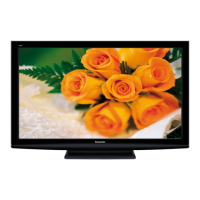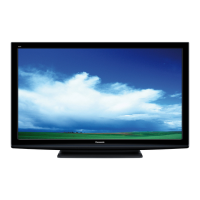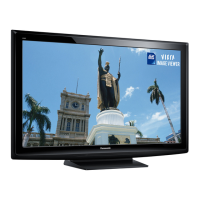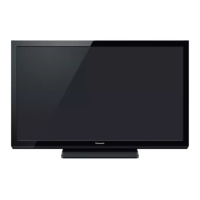
Do you have a question about the Panasonic TC TC-P58S1 and is the answer not in the manual?
Key safety guidelines for proper operation, setup, and handling of the TV.
Details on FCC rules, radio frequency energy, and interference for digital devices.
Statement regarding digital apparatus compliance with Canadian regulations.
Precautions for safe TV installation, pedestal use, and handling to prevent injury.
Guidelines for safe use, handling, and connection of the AC power cord.
Advice on transporting, cleaning, and handling the TV safely to prevent damage.
Recommendations for child safety and secure wall mounting of the TV.
Information on preventing screen image retention and screen saver activation.
Guidance on TV placement concerning sunlight and fluorescent lighting effects.
List of included accessories, optional brackets, and battery installation for remote.
Instructions for attaching and setting up the TV pedestal securely.
Steps for connecting the AC cord and overview of antenna, pin, and HDMI terminals.
How to connect antennas and cable boxes for receiving TV signals.
Information on using cable boxes for programming and high-definition viewing.
Guide for connecting DVD recorders or VCRs for recording and playback functions.
Instructions for connecting DVD recorders and satellite receivers to the TV.
How to connect devices using HDMI and Component video cables for best quality.
How to connect devices using S-Video and Composite video cables.
Location and function of TV buttons, sensors, and connectors on front and back.
Explanation of buttons and their operations on the provided TV remote control.
First steps to turn on the TV and select the display language.
Choosing between "Home Use" and "Store Demonstration" modes.
Steps to set the current time and date on the TV.
Configuring antenna/cable input and performing auto channel programming.
Options for scanning analog, digital, or all channels for TV reception.
Customizing labels for connected external input devices for easier identification.
How to turn on the TV, select channels, and use basic viewing functions.
Adjusting audio modes (SAP) and controlling closed captions display.
Displaying channel information and changing aspect ratios for viewing.
Setting up and using favorite channel lists for quick access.
How to display and navigate the VIERA TOOLS shortcut menu.
Overview of VIERA TOOLS functions like VIERA Link, Slideshow, and Picture modes.
Steps for inserting an SD card and viewing photos or slideshows.
Customizing picture adjustments for optimal viewing of photos.
Setting up slideshow playback speed and repeat function.
How to select and label different input sources for AV equipment.
Steps to enable and configure VIERA Link settings for connected devices.
Guide to display and navigate through the TV's main and sub-menus.
How to adjust picture and audio parameters via the menu system.
Fine-tuning picture modes, contrast, brightness, color, and aspect ratio.
Adjusting bass, treble, balance, surround sound, and speaker output.
Guide to access and utilize advanced menu settings and sub menus.
Settings for channel surf mode, language, clock, and connected devices.
Options for power saving, auto power, and signal loss shut-off.
Overview of operations enabled by HDAVI Control on connected equipment.
Information on using compliant HDMI cables for VIERA Link connections.
Diagrams and instructions for connecting various AV devices using HDMI.
Step-by-step guide to set VIERA Link options like Power on/off link and speakers.
How VIERA Link manages input switching and playback sequences.
Information transmitted from TV to connected recorders or home theaters.
Steps to display and select items within the VIERA Link menu.
Adjusting speaker output and controlling connected equipment via TV remote.
Choosing between TV or home theater speakers for audio output.
Using the TV remote to control connected HDMI devices.
Steps to access the lock menu, enter password, and select lock mode.
Methods for locking specific channels or game inputs.
Using V-chip to lock programs based on age-based ratings.
Procedure for changing the 4-digit password for lock settings.
How to perform automatic channel search and setup.
Adding, skipping, or editing channel information and favorites.
How to check signal strength for interference or image quality issues.
Configuring basic and advanced settings for closed caption display.
Customizing input labels for easier identification of connected equipment.
Configuring the TV to automatically turn on or off at scheduled times.
Recommended connections for viewing camcorder footage.
Recommended connections for listening to TV audio through speakers.
Recommended connections for DVDs, set-top boxes, and digital video.
Explanation of MPAA and U.S. TV rating systems for content locking.
Explanation of Canadian English and French rating systems for content locking.
Details on CC display compatibility and signal requirements.
How to adjust aspect ratios and zoom for optimal viewing.
Specifications for SD card compatibility and safe handling procedures.
Details on VIERA Link functionality and HDMI connectivity.
Information on digital audio output and available picture modes.
Options for managing 4:3 aspect ratio side bars and scrolling bar features.
List of input signal formats compatible with the TV display.
Guidelines for safely cleaning the TV's screen surface.
Instructions for cleaning the TV's body and stand.
Solutions for white spots, noise, and distorted pictures from external equipment.
Troubleshooting for remote control not working and recording problems.
Solutions for screen display problems and no sound issues.
Troubleshooting for TV set heating, unusual sounds, and other sound problems.
Detailed technical specifications including dimensions, power, and terminals.
Details on what the limited warranty covers and does not cover.
Contact info for product assistance, service, and parts purchases.
Information on purchasing accessories and instruction books online.
Details on warranty coverage, limitations, and exclusions for Canadian purchases.
Space to record model and serial numbers for warranty and identification.












